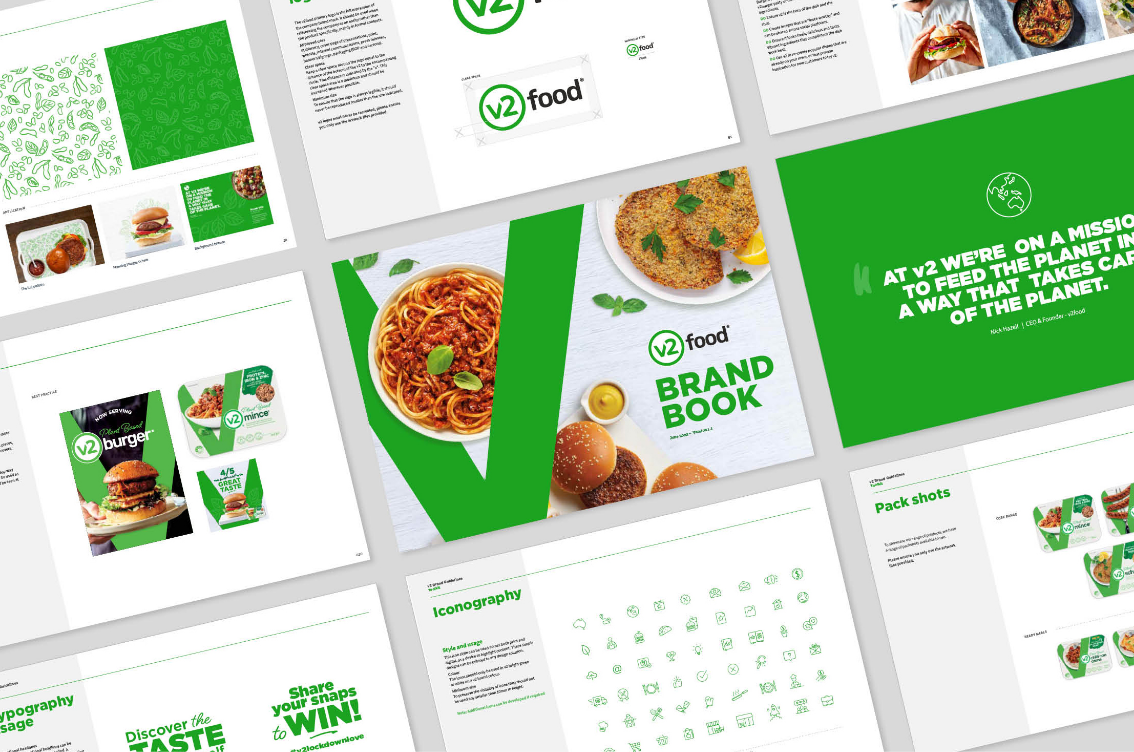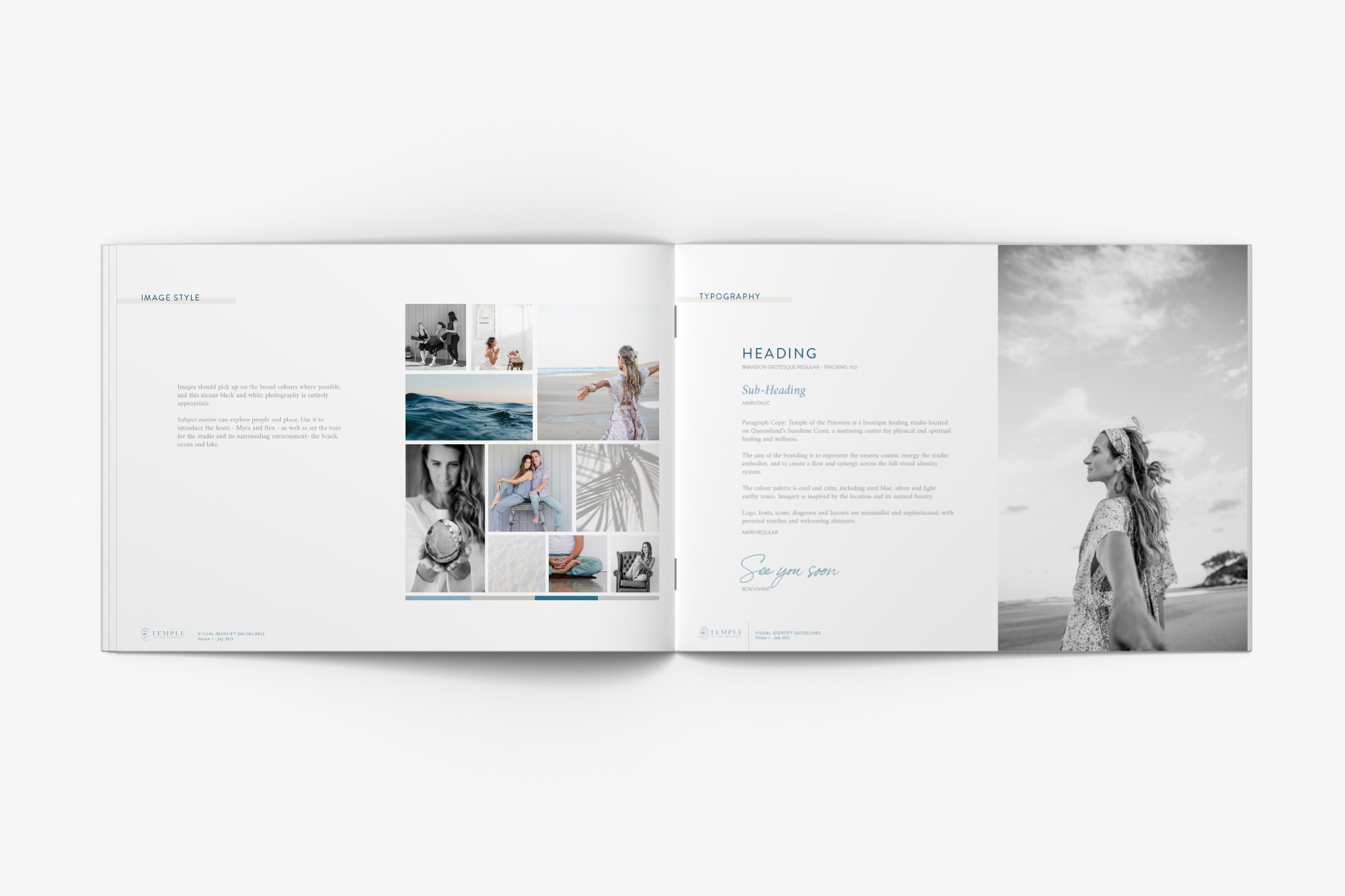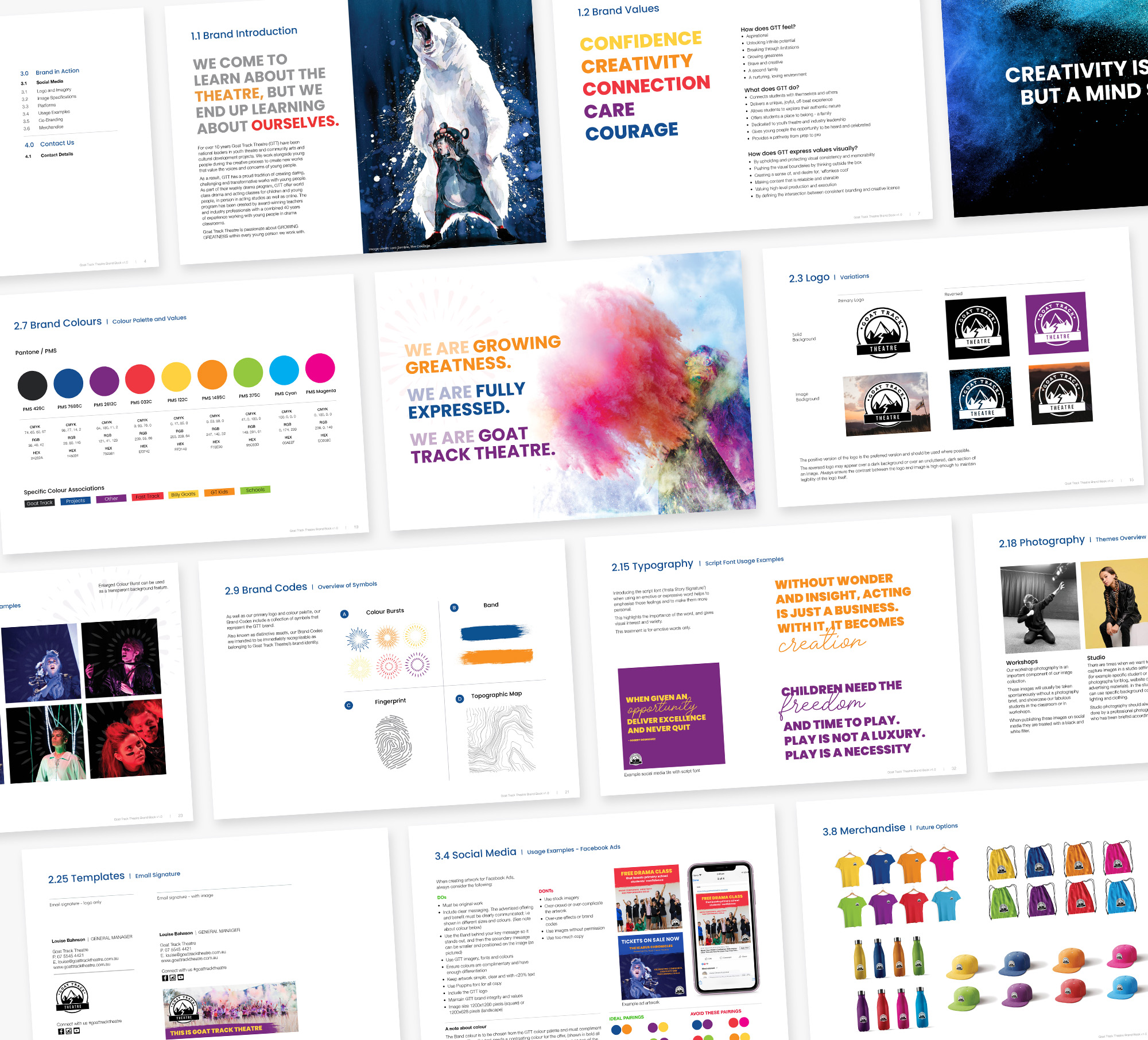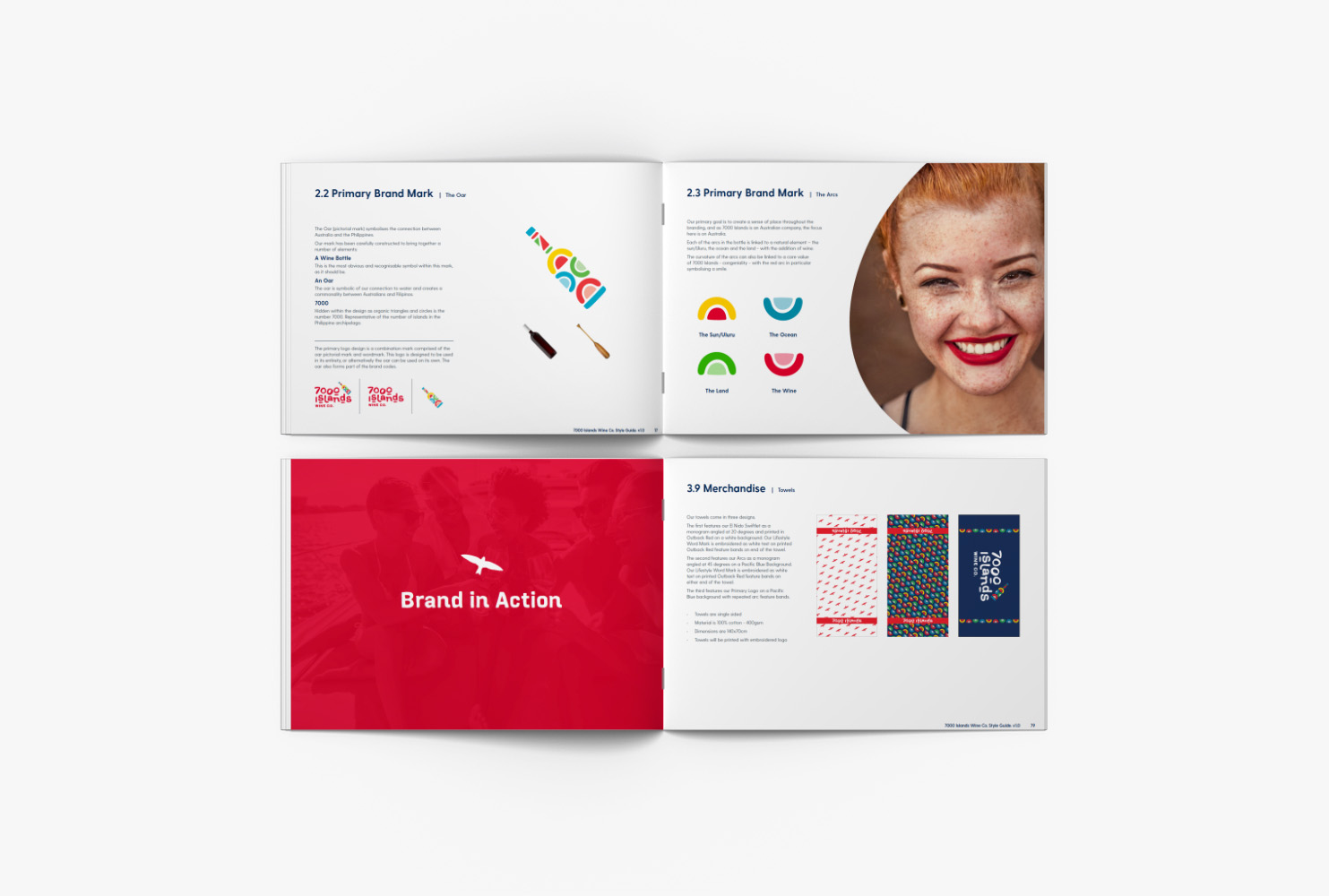A Style Guide is a document that outlines a company’s preferred visual and written standards. Also referred to as Brand Guidelines, Style Guides cover things like logo usage, typography, colour palette, imagery, iconography, illustration, and tone of voice. A Style Guide’s purpose is to ensure consistency in the way a brand is presented across all touchpoints, from stationery to social media, internal communications to advertising materials. This consistency is essential for creating a strong and recognisable brand identity.

How big is a Style Guide?
Style Guides come in many shapes and sizes, from single-page PDFs to extensive books with chapters or sections. Some companies have begun opting for live web-based guidelines with links. The size and format of a Style Guide will vary depending on the company’s needs, but generally speaking it will be proportionate to the size and complexity of the business, and should be comprehensive enough to cover all the necessary guidelines for the company’s branding.
A very basic Style Guide will include guidelines for logo usage, colour and typography at an absolute minimum. We usually find that clients that opt for single-page guidelines struggle when it comes to creating marketing and advertising materials including social media content as the possibilities of what to create are too open- the goal posts are too wide. Having an adequate amount of rules and structure actually aids in the creative process as well as the management of the brand.
What to include
We recommend that most small to medium businesses include the following in their brand guidelines:
Brand identity elements: guidelines for the use of the business’s logo, including approved colour variations, lockups, minimum size requirements, and placement guidelines.
Typography: guidelines for the use of typography, including typefaces, font sizes, and hierarchy.
Colour palette: guidelines for the use of colour, including primary and secondary colours, and how they should be used in different contexts.
Imagery: guidelines for the use of imagery, including photo and illustration styles, and how they should be used in different contexts. If the brand utilises patterns or iconography, this should also be included.
Tone of voice: guidelines for the language and tone to be used in all company communications, including messaging, copy, and social media.
Layout: guidelines for layout and design elements, such as grids, spacing, and alignment.
Social media: guidelines for the use of social media, including profile images, cover photos, and how to interact with customers.
Email signature: guidelines for creating a consistent email signature for all employees.
Business card: guidelines for creating a consistent business card for all employees.
Website: guidelines for website design, layout and content, including navigation, headlines, and calls to action.
Depending on the company’s needs, you can also include things like brand architecture, positioning and values, brand anchor or tagline, merchandise, co-branding, trademark information, and links to artwork files if appropriate.
Regardless of a Style Guide’s inclusions or size, guidelines should always be clear, specific and easy to follow.
When is a Style Guide needed and what is the process?
We’ve worked with clients wanting their Style Guide created immediately after their visual identity has been developed, and this is ideal timing as it ensures brand consistency from the very start. It’s not uncommon for the Style Guide to be revisited periodically thereafter with additional information included as the brand develops over time.
On the other hand, we’ve been engaged by clients who have been attempting to market and advertise for years without a Style Guide to no avail. Prior to engaging us, they were reinventing the wheel with each new piece of collateral, wasting valuable time and money and diluting any sense of brand they had in the process. We were able to build a wider visual identity around their existing logo and deliver clear brand guidelines in which to follow. They successfully implemented the guidelines and we’re happy to say we see their digital advertising on occasion, and it’s still following the template we created for them years ago. It makes our little designer hearts smile!
View the Goat Track Theatre Case Study here
The above situation, whilst workable, isn’t ideal. This is why we recommend including a Style Guide within the scope of a brand identity package and doing it right from the start.
Your Style Guide is a worthy investment
A Style Guide isn’t just a “value-add” tacked onto the end of a branding packaging. It is a valuable tool that can make the difference between confident and consistent presentation of your brand, or mixed messages that lead customers to distrust and disengage.
Think of a Style Guide as the instructions that come with your flat-packed furniture, or the recipe that tells you how to combine your ingredients. Brand assets such as a logo or font are simply the pieces of furniture or the ingredients until you’ve put them together in a way that achieves a desired outcome. Even though your brand assets are valuable, the ‘how, where, when and why’ of implementing them are just as important.
Businesses who choose not to invest in a Style Guide may face several challenges, including:
Inconsistency in branding: Without a style guide, different departments or employees may interpret the brand differently, leading to inconsistencies in the way the brand is presented.
Confusion among customers: Customers may become confused by different versions of the brand, or by inconsistent messaging and visual elements.
Difficulty in creating cohesive marketing materials: Without a style guide, it can be difficult for a company to create marketing materials that are cohesive and on-brand.
Difficulty in scaling the brand: Without a style guide, it can be difficult for a company to expand or scale the brand, as different versions of the brand may be used in different locations or by different franchises.
Difficulty in maintaining the brand’s reputation: Without a style guide, it can be difficult for a company to maintain the reputation of the brand, as different versions of the brand may be associated with different values or messages.
Difficulty in creating a strong visual identity: Without a style guide, it can be difficult for a company to create a strong visual identity that is easily recognizable and memorable.
Many years ago we worked with a state-wide hire company. They engaged us because they wanted to expand and scale, but quickly realised they had no guidelines for their brand. Upon further investigation, they also realised that each of their branches was using different versions of their logo, different colours, and had completely different signage. This was a massive and costly oversight. We ended up recommending a rebrand and consolidated all materials. A comprehensive Style Guide was created and successfully implemented. This led to substantially better brand consistency across the board and allowed the company to scale with confidence. They went on to win much larger contracts, expand interstate, and win numerous awards.
You can view the Master Hire Case Study here.

Common mistakes when creating a Style Guide
Not all Style Guides are created equal, and not all designers advise their clients on how to go about creating one. To help you effectively plan for your company’s Style Guide, avoid these common mistakes:
Not involving all stakeholders: Failing to involve all relevant parties, such as marketing, design, and communication teams, can lead to a style guide that doesn’t accurately reflect the needs of the organisation.
Not being specific enough: Vague or overly broad guidelines can lead to confusion and inconsistent implementation of the brand.
Not updating the style guide: Not regularly reviewing and updating the style guide can cause it to become outdated, which can lead to inconsistencies in branding.
Not providing examples: Not providing visual examples of how the guidelines should be applied can make it difficult for employees to understand and implement the brand correctly.
Not providing clear instructions: Not providing clear instructions for how to use the guidelines can lead to confusion and inconsistent implementation of the brand.
Not providing digital and print version of the guide: Not providing digital and print version of the guide can make it difficult for employees to access the guide when they need it.
Not providing an easy way to contact for questions: Not providing an easy way for employees to contact the relevant department or person for questions or clarification can lead to confusion and inconsistent implementation of the brand.
Not providing access to the required design assets: Not providing access to the required design assets, like fonts, logos, and colour codes, can make it difficult for employees to implement the guidelines correctly.
Not being flexible: Being too rigid with the guidelines can make it difficult for employees to be creative and adapt the brand to different contexts.
Not testing the guide: Not testing the guide with a sample group before rolling it out can lead to issues that were not anticipated.
Keep in mind that these are common mistakes and not all of them will apply to every business, but they can be a good start when thinking about the potential issues that can arise when creating a Style Guide.
An experienced designer can help guide their client on how best to create their company’s Style Guide. They will often have examples of previous work, and even templates that can be utilised as a starting point. Whether it’s a few pages with essential information, or a 100+ page “Brand Bible” (yes, we’ve created these!), always ensure your company has an up-to-date Style Guide. You invested in the brand assets, so invest in being shown how to use them!




0 Comments